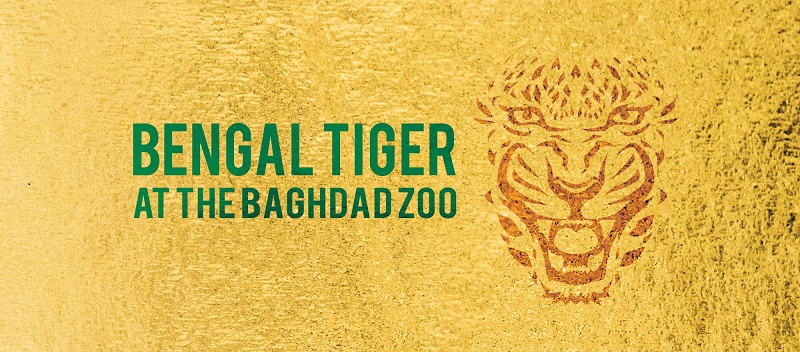I’ve just come from the matinee of Rajiv Joseph’s play Bengal Tiger at the Baghdad Zoo, presented by Crow’s Theatre in co-production with Modern Times Stage Company.
The title tells you the basic premise, a tiger is caged in a zoo far from its place of origin. It’s also the time of the Iraq war in 2003.
The Guloien Theatre space is configured as a square, a cage in the centre surrounded by rugs as we begin.

In the first minutes of the play we see a person (Kristen Thomson) in a cage, who we discover is portraying a tiger. We see no tiger costume but rather a person in a cage. This is only the first instance of many when we will be drawn in, invited to use our imaginations. While this war story may be based on recent events, while we see personages performing in Arabic languages without titles, creating an aura of realism: yet it’s a wild poetic fantasy including ghosts, guns and gore, even if we’re spared many of the grosser manifestations.
We begin with Kev (Christopher Allen) and Tom (Andrew Chown), two soldiers pacing around the cage with their weapons. When Tom carelessly reaches into the cage to offer some food to the tiger (how they see the woman in the cage) she tears his hand off: or so we’re told. Kev immediately kills her (the tiger): at which point she (the woman) steps between the bars of the cage. We’ve seen this for a long time in films, so it’s not troubling, indeed it makes a great deal of sense that the tiger and the humans can communicate, especially after they’ve died. She is but the first in a series of characters speaking from beyond the grave.

Musa (Ahmed Moneka) is a figure we’ve seen in generic terms in the news, the local whose work with the invaders puts him in a dangerously compromised position, let alone coping with his own conscience. First shown working as a translator, we discover other aspects of his life, especially his work as a gardener who created animal-shaped topiaries. The set design by Lorenzo Savoini even includes a series of vaguely lit topiary-figures hanging above us on all sides of the theatre. Sara Jaffri plays two very different characters, the ambiguity of that duality part of what’s haunting Musa. Mahsa Ershadifar who is listed as “Iraqi woman” seems to play more than one person although ambiguities in the play add a fascinating layer to our experience, wondering whether the character is the same one we saw, also whether they’re living or dead.
I saw it described as comedy by Rouvan Silogix (director of the play & artistic director of Modern Times Stage Company) in his program note. It’s darkly comic, full of profanity. Yes there are places where people laugh. Also places where people shudder, gasp, quiver in awe. It grows on you once you figure it out, knowing who’s who and what to expect. I found myself wondering how come Kev’s vocabulary had improved: until I remembered that we had seen him near death. And his after-life version explained to us that he was learning a great deal. Please don’t mistake my discussion of ghosts as something to be confused with Halloween or Ghostbusters, as we’re instead in a very spiritual realm even if the spirits onstage hurl questions at their creator.
The story is a surprisingly positive view from a dark place, moments where the characters struggle is truly life and death, including reflections from beyond the grave. There are some dark characters, for example Ali Kazmi in an overpowering portrayal of Uday Hussein, son of Saddam. To be precise, we never meet Uday as he’s already a ghost when he first comes strutting into the middle of the stage. His accoutrements remind me of the operatic Salome as he walks in carrying the grotesque severed head of his brother. Depending on where you sit and how you feel about this sort of thing, it may give you the giggles or trigger you. Think of this as very dark comedy. If you have any kind of history with wars or bombardments you might not see anything comical at all.
But it’s very well done. I think John Gzowski’s sound design may have contributed to the sense I had that many were cringing: which may be exactly what the director wanted. For something so full of artifice & theatricality it sometimes resembles something we might have seen on CNN during the Iraq War.
But it’s well done. It works.
There are people I know who wouldn’t want to see this because it would trigger their visceral memories of war. If you want something powerful and totally unlike anything you’ll see onstage in Toronto, this is the show for you, on until November 6th.


Pingback: Best of 2022 | barczablog